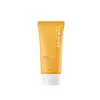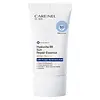What's inside
What's inside
 Key Ingredients
Key Ingredients

 Benefits
Benefits

 Concerns
Concerns

 Ingredients Side-by-side
Ingredients Side-by-side

Water
Skin ConditioningEthylhexyl Methoxycinnamate
UV AbsorberEthylhexyl Salicylate
UV AbsorberButylene Glycol
HumectantPhenylbenzimidazole Sulfonic Acid
UV AbsorberCaprylic/Capric Triglyceride
MaskingButyl Methoxydibenzoylmethane
UV AbsorberBis-Ethylhexyloxyphenol Methoxyphenyl Triazine
Skin ConditioningMethyl Methacrylate Crosspolymer
Glyceryl Stearate
EmollientCitrus Aurantifolia Flower Extract
AstringentCetearyl Olivate
Sea Water
HumectantPrunus Persica Flower Extract
MoisturisingCetearyl Alcohol
EmollientNylon-12
Sorbitan Olivate
EmulsifyingSodium Hydroxide
BufferingPyrus Malus Flower Extract
Skin ConditioningDimethicone
EmollientPolyacrylate-13
Panthenol
Skin ConditioningPolyisobutene
PEG-100 Stearate
Tocopheryl Acetate
AntioxidantPunica Granatum Flower Extract
Skin ConditioningSorbitan Stearate
EmulsifyingOryza Sativa Bran Extract
Skin ConditioningMalpighia Glabra Fruit Extract
Skin ConditioningAloe Barbadensis Leaf Extract
EmollientEucalyptus Globulus Leaf Extract
PerfumingRosa Damascena Flower Water
MaskingPrunus Avium Flower Extract
Skin ConditioningCitrus Aurantium Dulcis Flower Extract
Skin ConditioningCitrullus Lanatus Fruit Extract
Skin ConditioningSorbitan Isostearate
EmulsifyingPolysorbate 20
EmulsifyingBHT
AntioxidantDisodium EDTA
1,2-Hexanediol
Skin ConditioningEthylhexylglycerin
Skin ConditioningCaprylyl Glycol
EmollientParfum
MaskingWater, Ethylhexyl Methoxycinnamate, Ethylhexyl Salicylate, Butylene Glycol, Phenylbenzimidazole Sulfonic Acid, Caprylic/Capric Triglyceride, Butyl Methoxydibenzoylmethane, Bis-Ethylhexyloxyphenol Methoxyphenyl Triazine, Methyl Methacrylate Crosspolymer, Glyceryl Stearate, Citrus Aurantifolia Flower Extract, Cetearyl Olivate, Sea Water, Prunus Persica Flower Extract, Cetearyl Alcohol, Nylon-12, Sorbitan Olivate, Sodium Hydroxide, Pyrus Malus Flower Extract, Dimethicone, Polyacrylate-13, Panthenol, Polyisobutene, PEG-100 Stearate, Tocopheryl Acetate, Punica Granatum Flower Extract, Sorbitan Stearate, Oryza Sativa Bran Extract, Malpighia Glabra Fruit Extract, Aloe Barbadensis Leaf Extract, Eucalyptus Globulus Leaf Extract, Rosa Damascena Flower Water, Prunus Avium Flower Extract, Citrus Aurantium Dulcis Flower Extract, Citrullus Lanatus Fruit Extract, Sorbitan Isostearate, Polysorbate 20, BHT, Disodium EDTA, 1,2-Hexanediol, Ethylhexylglycerin, Caprylyl Glycol, Parfum
Water
Skin ConditioningButylene Glycol
HumectantDibutyl Adipate
EmollientButyloctyl Salicylate
Skin ConditioningEthylhexyl Triazone
UV AbsorberDiethylamino Hydroxybenzoyl Hexyl Benzoate
UV FilterSilica
AbrasiveNiacinamide
SmoothingC12-15 Alkyl Benzoate
AntimicrobialDrometrizole Trisiloxane
UV AbsorberMethylene Bis-Benzotriazolyl Tetramethylbutylphenol
UV Filter1,2-Hexanediol
Skin ConditioningBis-Ethylhexyloxyphenol Methoxyphenyl Triazine
Skin ConditioningPropanediol
SolventCaprylyl Methicone
Skin ConditioningBenzotriazolyl Dodecyl P-Cresol
UV AbsorberDicaprylyl Carbonate
EmollientDiethylhexyl 2,6-Naphthalate
EmollientCaprylic/Capric/Succinic Triglyceride
EmollientAmmonium Acryloyldimethyltaurate/Vp Copolymer
Decyl Glucoside
CleansingTromethamine
BufferingAcrylates/C10-30 Alkyl Acrylate Crosspolymer
Emulsion StabilisingHydroxypropyl Methylcellulose Stearoxy Ether
Sodium Stearoyl Glutamate
CleansingPanthenol
Skin ConditioningEthylhexylglycerin
Skin ConditioningAdenosine
Skin ConditioningGlycerin
HumectantXanthan Gum
EmulsifyingTocopherol
AntioxidantXylitylglucoside
HumectantAnhydroxylitol
HumectantXylitol
HumectantSodium Hyaluronate
HumectantHouttuynia Cordata Extract
Skin ConditioningHydroxypropyltrimonium Hyaluronate
Sodium Acetylated Hyaluronate
HumectantHydrolyzed Hyaluronic Acid
HumectantHyaluronic Acid
HumectantSodium Hyaluronate Crosspolymer
HumectantHydrolyzed Sodium Hyaluronate
Skin ConditioningPotassium Hyaluronate
Skin ConditioningParfum
MaskingWater, Butylene Glycol, Dibutyl Adipate, Butyloctyl Salicylate, Ethylhexyl Triazone, Diethylamino Hydroxybenzoyl Hexyl Benzoate, Silica, Niacinamide, C12-15 Alkyl Benzoate, Drometrizole Trisiloxane, Methylene Bis-Benzotriazolyl Tetramethylbutylphenol, 1,2-Hexanediol, Bis-Ethylhexyloxyphenol Methoxyphenyl Triazine, Propanediol, Caprylyl Methicone, Benzotriazolyl Dodecyl P-Cresol, Dicaprylyl Carbonate, Diethylhexyl 2,6-Naphthalate, Caprylic/Capric/Succinic Triglyceride, Ammonium Acryloyldimethyltaurate/Vp Copolymer, Decyl Glucoside, Tromethamine, Acrylates/C10-30 Alkyl Acrylate Crosspolymer, Hydroxypropyl Methylcellulose Stearoxy Ether, Sodium Stearoyl Glutamate, Panthenol, Ethylhexylglycerin, Adenosine, Glycerin, Xanthan Gum, Tocopherol, Xylitylglucoside, Anhydroxylitol, Xylitol, Sodium Hyaluronate, Houttuynia Cordata Extract, Hydroxypropyltrimonium Hyaluronate, Sodium Acetylated Hyaluronate, Hydrolyzed Hyaluronic Acid, Hyaluronic Acid, Sodium Hyaluronate Crosspolymer, Hydrolyzed Sodium Hyaluronate, Potassium Hyaluronate, Parfum
 Reviews
Reviews

Ingredients Explained
These ingredients are found in both products.
Ingredients higher up in an ingredient list are typically present in a larger amount.
1,2-Hexanediol is a synthetic liquid and another multi-functional powerhouse.
It is a:
- Humectant, drawing moisture into the skin
- Emollient, helping to soften skin
- Solvent, dispersing and stabilizing formulas
- Preservative booster, enhancing the antimicrobial activity of other preservatives
You might know this ingredient as Tinosorb S or Bemotrizinol. It is a UV filter that covers both UVA and UVB rays.
This ingredient has two peak UV absorption peaks ( 310 and 340 nm) and is able to absorb both UV-A and UV-B rays. This ingredient works by preventing UV rays from reaching and damaging your skin.
On top of that - it is highly photostable and helps prevent the photodegration of other sunscreen ingredients such as avobenzone.
Tinosorb S is allowed in the EU, Australia, and Asia. It is close to being approved by the FDA and we'll hopefully get this ingredient in the U.S. by late 2025.
Fun fact: Tinosorb S is the most effective UV absorber at maximum concentration (measured by SPF) permitted in the EU.
This ingredient is oil-soluble, so your oil-cleansers will take this right off at night.
Learn more about Bis-Ethylhexyloxyphenol Methoxyphenyl TriazineButylene Glycol (or BG) is used within cosmetic products for a few different reasons:
Overall, Butylene Glycol is a safe and well-rounded ingredient that works well with other ingredients.
Though this ingredient works well with most skin types, some people with sensitive skin may experience a reaction such as allergic rashes, closed comedones, or itchiness.
Learn more about Butylene GlycolEthylhexylglycerin (we can't pronounce this either) is commonly used as a preservative and skin softener. It is derived from glyceryl.
You might see Ethylhexylglycerin often paired with other preservatives such as phenoxyethanol. Ethylhexylglycerin has been found to increase the effectiveness of these other preservatives.
Panthenol is a common ingredient that helps hydrate and soothe the skin. It is found naturally in our skin and hair.
There are two forms of panthenol: D and L.
D-panthenol is also known as dexpanthenol. Most cosmetics use dexpanthenol or a mixture of D and L-panthenol.
Panthenol is famous due to its ability to go deeper into the skin's layers. Using this ingredient has numerous pros (and no cons):
Like hyaluronic acid, panthenol is a humectant. Humectants are able to bind and hold large amounts of water to keep skin hydrated.
This ingredient works well for wound healing. It works by increasing tissue in the wound and helps close open wounds.
Once oxidized, panthenol converts to pantothenic acid. Panthothenic acid is found in all living cells.
This ingredient is also referred to as pro-vitamin B5.
Learn more about PanthenolParfum is a catch-all term for an ingredient or more that is used to give a scent to products.
Also called "fragrance", this ingredient can be a blend of hundreds of chemicals or plant oils. This means every product with "fragrance" or "parfum" in the ingredients list is a different mixture.
For instance, Habanolide is a proprietary trade name for a specific aroma chemical. When used as a fragrance ingredient in cosmetics, most aroma chemicals fall under the broad labeling category of “FRAGRANCE” or “PARFUM” according to EU and US regulations.
The term 'parfum' or 'fragrance' is not regulated in many countries. In many cases, it is up to the brand to define this term.
For instance, many brands choose to label themselves as "fragrance-free" because they are not using synthetic fragrances. However, their products may still contain ingredients such as essential oils that are considered a fragrance by INCI standards.
One example is Calendula flower extract. Calendula is an essential oil that still imparts a scent or 'fragrance'.
Depending on the blend, the ingredients in the mixture can cause allergies and sensitivities on the skin. Some ingredients that are known EU allergens include linalool and citronellol.
Parfum can also be used to mask or cover an unpleasant scent.
The bottom line is: not all fragrances/parfum/ingredients are created equally. If you are worried about fragrances, we recommend taking a closer look at an ingredient. And of course, we always recommend speaking with a professional.
Learn more about ParfumWater. It's the most common cosmetic ingredient of all. You'll usually see it at the top of ingredient lists, meaning that it makes up the largest part of the product.
So why is it so popular? Water most often acts as a solvent - this means that it helps dissolve other ingredients into the formulation.
You'll also recognize water as that liquid we all need to stay alive. If you see this, drink a glass of water. Stay hydrated!
Learn more about Water